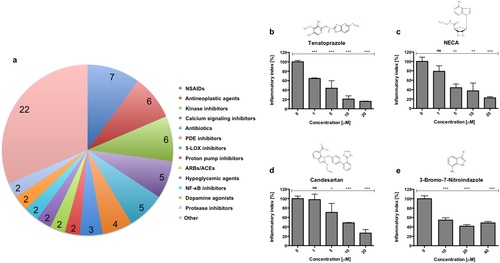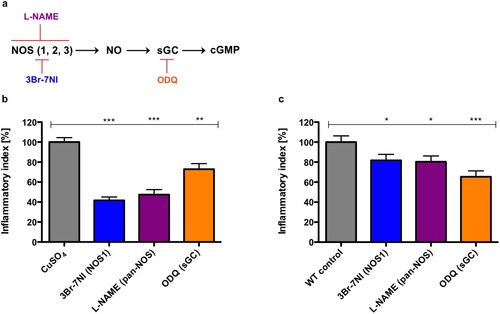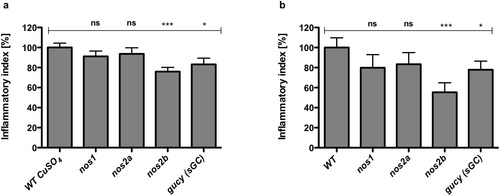- Title
-
A Zebrafish Drug-Repurposing Screen Reveals sGC-Dependent and sGC-Independent Pro-Inflammatory Activities of Nitric Oxide
- Authors
- Wittmann, C., Reischl, M., Shah, A.H., Kronfuss, E., Mikut, R., Liebel, U., Grabher, C.
- Source
- Full text @ PLoS One
|
Functional classification and validation of selected anti-inflammatory hits. Anti-inflammatory candidates were classified in functional or therapeutic groups. Selected anti-inflammatory hit compounds exert dose-dependent anti-inflammatory effect on chemically induced inflammation. (a) Pie chart dividing the 70 anti-inflammatory hit compounds in functional or therapeutic groups containing at least 2 representatives (numbers). Groups with only one representative are summarized in “other”. (b-e) Dose-response behavior of selected anti-inflammatory hit compounds Tenatoprazole (b), NECA (c), Candesartan (d), and 3-Bromo-7-nitroindazole (e). Bar charts indicate means ± SEM of the initial inflammatory index (%) 90 minutes after CuSO4 treatment (t = 0). Three individual experiments were performed with 15 replicate larvae for each condition, respectively. Statistics were evaluated with unpaired one-sided t-tests. ns–not significant: P > 0.05, * P < 0.05, ** P < 0.01, *** P < 0.001. PHENOTYPE:
|
|
Nitric oxide is a pro-inflammatory signal upon peripheral sensory nervous system and epithelial tissue injuries. Inhibition of NOS and sGC significantly impairs leukocyte-to-wound attraction in both inflammation scenarios. (a) Schematic of the NO signaling pathway. Relevant chemical inhibitors acting on individual pathway components are indicated and color-coded. (b, c) Bar charts representing the effect of the pan-NOS inhibitor L-NAME (magenta) (ChIn: 250 µM, ventral: 1000 µM), the NOS1 inhibitor 3-Bromo-7-nitroindazole (blue) (3Br-7NI) (20 µM) and the sGC inhibitor ODQ (orange) (20 µM) on inflammation of the peripheral sensory nervous system assessed by the ChIn assay (b) and on epithelial inflammation assessed by mechanically induced injury of the ventral fin (c). Bar charts represent means of the inflammatory index (%) ± SEM. Three individual experiments were performed with 15 replicate larvae for each condition, respectively. Statistics were evaluated with unpaired one-sided t-tests. ns-not significant: P > 0.05, * P < 0.05, ** P < 0.01, *** P < 0.001. PHENOTYPE:
|
|
Genetic knockdown of zebrafish nos2b and sGC (gucy) but not nos1 and nos2a impair the inflammatory response. Assessment of the role of the 3 zebrafish Nos isoforms and sGC on peripheral sensory nervous system (a) and epithelial (b) inflammation upon genetic knockdown. (a) nos2b and gucy knockdown significantly reduce initial inflammation at injured neuromasts as compared to wildtype (WT) larvae. (b) Knockdown of nos2b and gucy significantly reduce the number of neutrophils recruited to ventral fin wounds. Bar charts represent means of the initial inflammatory index (%) ± SEM 90 minutes after CuSO4 treatment (a) and 1 h after mechanical injury of the ventral fin (b). Three individual experiments were performed with 15 replicate morphant larvae for each condition, respectively. Statistics were evaluated with unpaired one-sided t-tests. ns–not significant: P > 0.05, * P < 0.05, ** P < 0.01, *** P < 0.001. PHENOTYPE:
|



